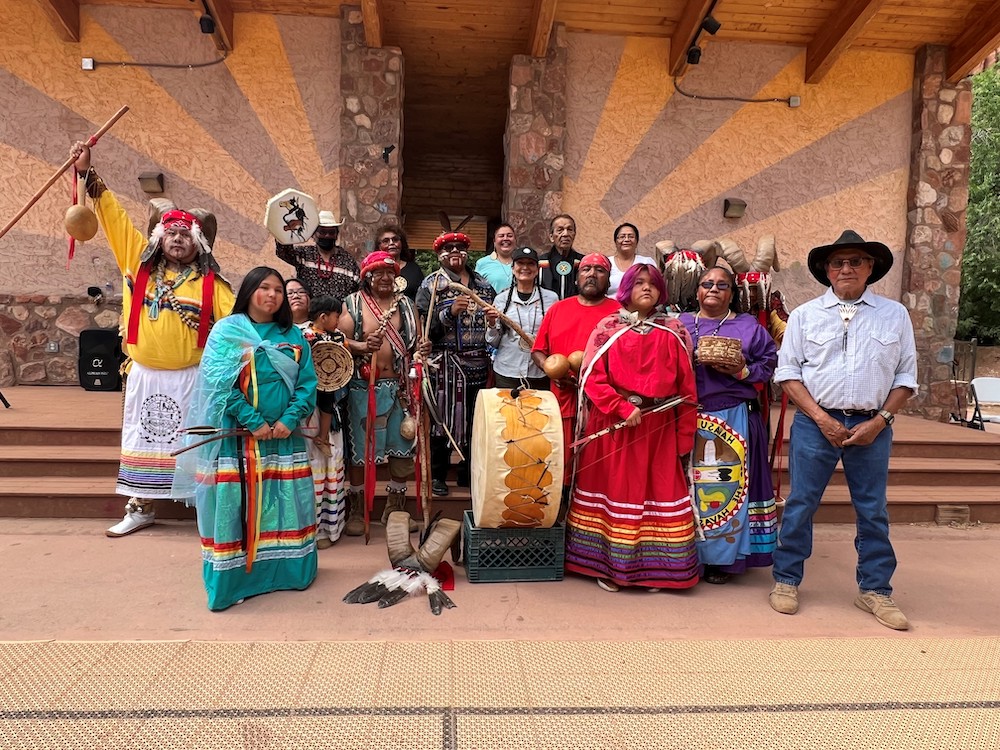
- Details
- By Kaili Berg
Tribal leaders, elected officials and community members met with Interior Secretary Deb Haaland (Laguna Pueblo) on Saturday in northern Arizona to talk about conservation efforts on the historic Grand Canyon watershed.
Haaland, along with leaders from the Bureau of Land Management, U.S. Forest Service, and National Park Service spoke with members of the Grand Canyon Tribal Coalition about the proposed Baaj Nwaavjo I’tah Kukveni Grand Canyon National Monument. U.S. Rep Raul Grijalva (D-AZ) and Sen. Krysten Sinema (I-AZ), who have proposed protections for the land, also attended the event.
The Grand Canyon Tribal Coalition consists of leadership representatives from a dozen tribes from throughout the southwestern U.S. They discussed the importance of the area and their efforts to permanently protect the watershed, which provides water to 40 million Americans, from the damaging effects of uranium mining.
Haaland’s visit was part of the federal government’s ongoing engagement and public dialogue related to this proposed Baaj Nwaavjo monument. The proposal would ultimately protect 1.1 million acres of important cultural land for Indigenous communities in the region which have been impacted by extensive health and environmental damage from uranium contamination.
“My tribe's effort to protect the Grand Canyon from uranium mining began in 1984 and has taken the majority of my lifetime,” Carletta Tilousi, a tribal coalition member, told Native News Online. “My tribe has fought this development for nearly 39 years.”
Haaland tweeted of the visit: “The Grand Canyon and its surrounding areas reflect the beauty of our outdoor spaces and the importance of protecting them for future generations. It was incredibly powerful to hear from tribal leaders, local elected officials, and community members to learn about their vision for conserving the natural and cultural resources in the greater Grand Canyon watershed.”
The Grand Canyon National park is now one of the most visited parks in America. It is a major economic driver for the local communities where the monument is located. The U.S Bureau of Economic Analysis recently released a report that shows outdoor recreation in Arizona to be rapidly growing, adding more than $9.8 billion to the state’s economy in 2021 and providing over 100,000 jobs. Outdoor recreation, like fishing, hunting, and camping accounted for more than 2 percent of Arizona’s total gross domestic product in 2021.
Following her visit with the coalition, Haaland hiked eight miles into Supai Village to meet with members of the Havasupai Tribal Council and members of the Havasupai Tribe. The Secretary is the highest-ranking federal official to ever visit the remote reservation, which is located at the bottom of the Grand Canyon.
Council members shared their concerns about the lack of education services being offered to tribal youth, the shortage of federal law enforcement officers serving the Tribe, and the ongoing threat of uranium mining on the Tribe’s only water source, Havasu Creek. The creek provides water to those who live in the canyon and also creates the renowned waterfalls that attract thousands of visitors to the reservation each year.
During her visit, which included a tour of Havasupai Elementary School, Haaland experienced cultural dances and songs performed by the Guardians of the Grand Canyon and participated in cultural social dances with Tribal members.
Havasupai Tribal Chairman Thomas Siyuja, Sr. welcomed the visit from Haaland. “She heard from us personally and saw with her own eyes the failures of the Bureau of Indian Education school system and Bureau of Indian Affairs law enforcement on our reservation,” Siyuja said in a statement.
More Stories Like This
Klamath Indigenous Land Trust Purchases 10,000 Acres as Salmon ReturnTrump signs law that revokes some limits on drilling in Alaska’s National Petroleum Reserve
Southern Sierra Miwuk Nation Gets 900-Acres ofLand Back
Chilkat Indian Village Tells New Palmer Mine Owners They Are “Not Welcome” in Chilkat Valley
Tribes, Coastal Group Ask Army Corps to Revoke Permit for Texas Export Terminal
Help us defend tribal sovereignty.
At Native News Online, our mission is rooted in telling the stories that strengthen sovereignty and uplift Indigenous voices — not just at year’s end, but every single day.
Because of your generosity last year, we were able to keep our reporters on the ground in tribal communities, at national gatherings and in the halls of Congress — covering the issues that matter most to Indian Country: sovereignty, culture, education, health and economic opportunity.
That support sustained us through a tough year in 2025. Now, as we look to the year ahead, we need your help right now to ensure warrior journalism remains strong — reporting that defends tribal sovereignty, amplifies Native truth, and holds power accountable.
 The stakes couldn't be higher. Your support keeps Native voices heard, Native stories told and Native sovereignty defended.
The stakes couldn't be higher. Your support keeps Native voices heard, Native stories told and Native sovereignty defended.
Stand with Warrior Journalism today.
Levi Rickert (Potawatomi), Editor & Publisher

